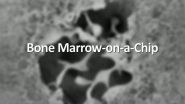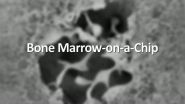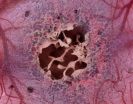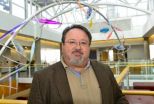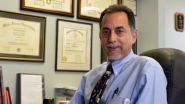(Press-News.org) VIDEO:
Wyss Institute Founding Director Don Ingber, Postdoctoral Fellow Yu-suke Torisawa, and Researcher Catherine Spina explain how and why they created bone marrow-on-a-chip, and how they got it to act like...
Click here for more information.
The latest organ-on-a-chip from Harvard's Wyss Institute for Biologically Inspired Engineering reproduces the structure, functions and cellular make-up of bone marrow, a complex tissue that until now could only be studied intact in living animals, Institute researchers report in the May 4, 2014, online issue of Nature Methods. The device, dubbed "bone marrow-on-a-chip," gives scientists a much-needed new tool to test the effects of new drugs and toxic agents on whole bone marrow.
Specifically, the device could be used to develop safe and effective strategies to prevent or treat radiation's lethal effects on bone marrow without resorting to animal testing, a challenge being pursued at the Institute with funding from the U.S. Food and Drug Administration (FDA). In an initial test, the engineered bone marrow, like human marrow, withered in response to radiation unless a drug known to prevent radiation poisoning was present.
The bone marrow-on-a-chip could also be used in the future to maintain a cancer patient's own marrow temporarily while he or she underwent marrow-damaging treatments such as radiation therapy or high-dose chemotherapy.
"Bone marrow is an incredibly complex organ that is responsible for producing all of the blood cell types in our body, and our bone marrow chips are able to recapitulate this complexity in its entirety and maintain it in a functional form in vitro," said Don Ingber, M.D., Ph.D., Founding Director of the Wyss Institute, Judah Folkman Professor of Vascular Biology at Harvard Medical School and Boston Children's Hospital, Professor of Bioengineering at the Harvard School of Engineering and Applied Sciences, and senior author of the paper.
Ingber leads a large effort to develop human organs-on-chips — small microfluidic devices that mimic the physiology of living organs. So far Wyss Institute teams have built lung, heart, kidney, and gut chips that reproduce key aspects of organ function, and they have more organs-on-chips in the works. The technology has been recognized internationally for its potential to replace animal testing of new drugs and environmental toxins, and as a new way for scientists to model human disease.
To build organ chips, in the past Wyss teams have combined multiple types of cells from an organ on a plastic microfluidic device, while steadily supplying nutrients, removing waste, and applying mechanical forces the tissues would face in the body. But bone marrow is so complex that they needed a new approach to mimic organ function.
This complexity arises because bone marrow has an integral relationship with bone. Marrow sits inside trabecular bone — a solid-looking type of bone with a porous, honeycombed interior. Throughout the honeycomb, conditions vary. Some areas are warmer, some cooler; some are oxygen-rich, others oxygen-starved, and the dozen or so cell types each have their own preferred spots. To add complexity, bone marrow cells communicate with each other by secreting and sensing a variety of biomolecules, which act locally to tell them whether to live, die, specialize or multiply.
Rather than trying to reproduce such a complex structure cell by cell, the researchers enlisted mice to do it.
"We figured, why not allow Mother Nature to help us build what she already knows how to build," said Catherine S. Spina, an M.D.-Ph.D. candidate at Boston University, researcher at the Wyss Institute, and co-lead author of the paper.
Specifically, Wyss Institute Postdoctoral Fellow Yu-suke Torisawa and Spina packed dried bone powder into an open, ring-shaped mold the size of a coin battery, and implanted the mold under the skin on the animal's back.
After eight weeks, they surgically removed the disk-shaped bone that had formed in the mold and examined it with a specialized CAT scanner. The scan showed a honeycomb-like structure that looked identical to natural trabecular bone.
The marrow looked like the real thing as well. When they stained the tissue and examined it under a microscope, the marrow was packed with blood cells, just like marrow from a living mouse. And when the researchers sorted the bone marrow cells by type and tallied their numbers, the mix of different types of blood and immune cells in the engineered bone marrow was identical to that in a mouse thighbone.
To sustain the engineered bone marrow outside of a living animal, the researchers surgically removed the engineered bone from mice, then placed it in a microfluidic device that mimics the circulation the tissue would experience in the body.
Marrow in the device remained healthy for up to one week. This is long enough, typically, to test the toxicity and effectiveness of a new drug.
The device also passed an initial test of its drug-testing capabilities. Like marrow from live mice, this engineered marrow was also susceptible to radiation — but an FDA-approved drug that protects irradiated patients also protected the marrow on the chip.
In the future, the researchers could potentially grow human bone marrow in immune-deficient mice. "This could be developed into an easy-to-use screening-based system that's personalized for individual patients," said coauthor James Collins, Ph.D., a Core Faculty member at the Wyss Institute and the William F. Warren Distinguished Professor at Boston University, where he leads the Center of Synthetic Biology.
Bone marrow-on-a-chip could also generate blood cells, which could circulate in an artificial circulatory system to supply a network of other organs-on-chips. The Defense Agency Advanced Research Projects Agency (DARPA) is funding efforts at the Wyss Institute to develop an interconnected network of ten organs-on-chips to study complex human physiology outside the body.
INFORMATION:
The work was funded by the U.S. Food and Drug Administration, DARPA, and the Wyss Institute for Biologically Inspired Engineering at Harvard University. In addition to Ingber, Torisawa, Spina and Collins, the authors included Tadanori Mammoto, Ph.D. and Akiko Mammoto, Ph.D., Instructors in Surgery at Boston Children's Hospital and Harvard Medical School, James Weaver, a Research Associate at the Wyss Institute, and Tracy Tat, a Research Technician at Boston Children's Hospital.
PRESS CONTACTS
Wyss Institute for Biologically Inspired Engineering at Harvard University
Dan Ferber
dan.ferber@wyss.harvard.edu
+1 617-432-1547
Boston University College of Engineering
Michael Seele
mseele@bu.edu
+1 617-353-9766
Harvard School of Engineering and Applied Sciences
Caroline Perry
cperry@seas.harvard.edu
+1 617-496-1351
IMAGES AND VIDEO AVAILABLE
About the Wyss Institute for Biologically Inspired Engineering at Harvard University
The Wyss Institute for Biologically Inspired Engineering at Harvard University uses Nature's design principles to develop bioinspired materials and devices that will transform medicine and create a more sustainable world. Working as an alliance among Harvard's Schools of Medicine, Engineering, and Arts & Sciences, and in partnership with Beth Israel Deaconess Medical Center, Brigham and Women's Hospital, Boston Children's Hospital, Dana Farber Cancer Institute, Massachusetts General Hospital, the University of Massachusetts Medical School, Spaulding Rehabilitation Hospital, Boston University, Tufts University, and Charité - Universitätsmedizin Berlin, the Institute crosses disciplinary and institutional barriers to engage in high-risk research that leads to transformative technological breakthroughs. By emulating Nature's principles for self-organizing and self-regulating, Wyss researchers are developing innovative new engineering solutions for healthcare, energy, architecture, robotics, and manufacturing. These technologies are translated into commercial products and therapies through collaborations with clinical investigators, corporate alliances, and new start-ups.
The Boston University College of Engineering offers a wide range of undergraduate, graduate and professional degrees in foundational and emerging engineering disciplines. Underlying the College's educational efforts is its commitment to creating Societal Engineers, who have an appreciation for how the engineer's unique skills can be used to improve our quality of life. Ranked among the nation's best engineering research institutions, the College's faculty attracts more than $50 million in external research support annually.
About the Harvard School of Engineering and Applied Sciences
The Harvard School of Engineering and Applied Sciences (SEAS) serves as the connector and integrator of Harvard's teaching and research efforts in engineering, applied sciences, and technology. Through collaboration with researchers from all parts of Harvard, other universities, and corporate and foundational partners, we bring discovery and innovation directly to bear on improving human life and society. For more information, visit: http://seas.harvard.edu. END
Bone marrow-on-a-chip unveiled
Device captures complexity of living marrow in the laboratory; could help test new drugs to prevent lethal radiation exposure
2014-05-05
ELSE PRESS RELEASES FROM THIS DATE:
A journey between XX and XY
2014-05-05
A team of researchers from the University of Geneva (UNIGE) has been involved in a thorough genetic investigation based on the case of a child suffering from the Nivelon-Nivelon-Mabille Syndrome, a complex condition characterised mainly by a sexual development disorder. Following a genome analysis of the patient and parents, the scientists, led by Serge Nef, Professor of the Department of Genetic Medicine and Development in the Faculty of Medicine, have identified not only the gene, but also the protein-producing mechanism, whose malfunctioning causes the syndrome in question. ...
Genetic approach helps design broadband metamaterial
2014-05-05
A specially formed material that can provide custom broadband absorption in the infrared can be identified and manufactured using "genetic algorithms," according to Penn State engineers, who say these metamaterials can shield objects from view by infrared sensors, protect instruments and be manufactured to cover a variety of wavelengths.
"The metamaterial has a high absorption over broad bandwidth," said Jeremy A. Bossard, postdoctoral fellow in electrical engineering. "Other screens have been developed for a narrow bandwidth, but this is the first that can cover a super-octave ...
Domestic violence victims more likely to take up smoking
2014-05-05
One third of women around the world have experienced physical or sexual violence at the hands of their intimate partners with consequences from post-traumatic stress disorder, anxiety, and depression, to sexually transmitted diseases, including HIV. Now, in a new study in 29 low-income and middle-income countries, researchers at Columbia University's Mailman School of Public Health have identified yet another serious health risk associated with intimate partner violence (IPV): smoking.
The researchers examined the association between IPV and smoking among 231,892 women ...
Soy sauce molecule may unlock drug therapy for HIV patients
2014-05-05
COLUMBIA, Mo. – For HIV patients being treated with anti-AIDS medications, resistance to drug therapy regimens is commonplace. Often, patients develop resistance to first-line drug therapies, such as Tenofovir, and are forced to adopt more potent medications. Virologists at the University of Missouri now are testing the next generation of medications that stop HIV from spreading, and are using a molecule related to flavor enhancers found in soy sauce, to develop compounds that are more potent than Tenofovir.
"Patients who are treated for HIV infections with Tenofovir, ...
Terahertz imaging on the cheap
2014-05-05
Terahertz imaging, which is already familiar from airport security checkpoints, has a number of other promising applications — from explosives detection to collision avoidance in cars. Like sonar or radar, terahertz imaging produces an image by comparing measurements across an array of sensors. Those arrays have to be very dense, since the distance between sensors is proportional to wavelength.
In the latest issue of IEEE Transactions on Antennas and Propagation, researchers in MIT's Research Laboratory for Electronics describe a new technique that could reduce the number ...
History to blame for slow crop taming: Study
2014-05-05
It's been about 10,000 years since our ancestors began farming, but crop domestication has taken much longer than expected – a delay caused less by genetics and more by culture and history, according to a new study co-authored by University of Guelph researchers.
The new paper digs at the roots not just of crop domestication but of civilization itself, says plant agriculture professor Lewis Lukens. "How did humans get food? Without domestication – without food – it's hard for populations to settle down," he said. "Domestication was the key for all subsequent human civilization."
The ...
Spotting a famous face in the crowd
2014-05-05
People can only recognize two faces in a crowd at a time – even if the faces belong to famous people. So says Volker Thoma of the University of East London in the UK in an article which sheds light on people's ability to process faces, published in Springer's journal Psychonomic Bulletin & Review. The findings have relevance to giving eye-witness testimony or for neuropsychological rehabilitation.
Thoma set up two experiments in which participants were asked to identify a famous politician such as Tony Blair and Bill Clinton or pop stars such as Mick Jagger and Robbie ...
Virtual patients, medical records and sleep queries may help reduce suicide
2014-05-05
AUGUSTA, Ga. - A virtual patient, the electronic medical record, and questions about how well patients sleep appear effective new tools in recognizing suicide risk, researchers say.
A fourth – and perhaps more powerful – tool against suicide is the comfort level of caregivers and family members in talking openly about it, said Dr. W. Vaughn McCall, Chairman of the Department of Psychiatry and Health Behavior at the Medical College of Georgia at Georgia Regents University.
Suicide is among the top 10 causes of death in the United States for every group age 10 and older, ...
Light-sensitive 'eyes' in plants
2014-05-05
Most plants try to turn towards the sun. Scientists from the University of Gothenburg have worked with Finnish colleagues to understand how light-sensitive proteins in plant cells change when they discover light. The results have been published in the most recent issue of Nature.
The family of proteins involved is known as the "phytochrome" family, and these proteins are found in all plant leaves. These proteins detect the presence of light and inform the cell whether it is day or night, or whether the plant is in the shade or the sun.
"You can think of them as the ...
Study reveals potentially unnecessary radiation after suspected sports-related injury
2014-05-05
VANCOUVER, BRITISH COLUMBIA – A new study of Utah youth with suspected sports-related head injuries found that emergency room visits for children with sports-related head injuries have increased since the state's concussion law passed in 2011, along with a rise in head CT scans -- leading to potentially unnecessary radiation exposure.
The results were announced at the Pediatric Academic Societies conference in Vancouver, British Columbia in May by William McDonnell, M.D., J.D., associate professor of pediatrics at the University of Utah.
The study, completed by McDonnell ...
LAST 30 PRESS RELEASES:
Insilico Medicine and Taigen achieves license agreement to develop and commercialize AI-driven PHD inhibitor for anemia of Chronic Kidney Disease (CKD)
Exploring dominant endophytic Pleosporales in grasses: New taxonomic insights in the suborder Massarineae
Comparative transcriptomic analysis of human maxillary and mandibular tooth germs reveals discrepancies in gene expression patterns
Scientists detect atmosphere on molten rocky exoplanet - study
Chip-scale magnetometer uses light for high-precision magnetic sensing
Illinois Tech biomedical engineering professor Philip R. Troyk elected as Fellow of the National Academy of Inventors
The National Academy of Inventors welcomes 2025 Class of Fellows
Multi-scale modelling framework predicts mechanical responses of Fe–Cr–Al alloys across composition and processing conditions
Preoperative radiation may improve antitumor immune response in most common form of breast cancer
Breast MRI may be safely omitted from diagnostic workup in certain patients with early-stage, HR-negative breast cancer
Sentinel lymph node biopsy may be safely omitted in some patients with early-stage breast cancer
Rats may seek cannabis to cope with stress
New FAU research strengthens evidence linking alcohol use to cancer
Gut health à la CAR T
Dr. Pengfei Liu receives 2026 O'Donnell Award in Medicine for pioneering advances in genetic diagnostics and rare disease treatment
Dr. Yunsun Nam receives 2026 O'Donnell Award in Biological Sciences for pioneering RNA research transforming gene regulation and cancer therapy
Dr. Bilal Akin wins 2026 O'Donnell Award in Engineering for transformative work in EV energy systems and industrial automation
Dr. Fan Zhang receives 2026 O'Donnell Award in Physical Sciences for groundbreaking discoveries in quantum matter and topological physics
Dr. Yue Hu receives 2026 O'Donnell Award for revolutionizing energy operations with real-time AI and reinforcement learning
Greater risk that the political right falls for conspiracy theories
JMC Publication: Insilico’s AI platforms enable discovery of potent, selective, oral DGKα inhibitor to overcome checkpoint resistance
Targeting collagen signaling boosts drug delivery in pancreatic cancer
Valvular heart disease is common in cancer patients but interventions improve survival
When socially responsible investing backfires
Cuffless blood pressure technologies in wearable devices show promise to transform care
AI-based tool predicts future cardiovascular events in patients with angina
Researchers map how the cerebellum builds its connections with the rest of the brain during early development
Routine scans could detect early prostate radiotherapy changes
Fairness in AI: Study shows central role of human decision-making
Pandemic ‘beneath the surface’ has been quietly wiping out sea urchins around the world
[Press-News.org] Bone marrow-on-a-chip unveiledDevice captures complexity of living marrow in the laboratory; could help test new drugs to prevent lethal radiation exposure
